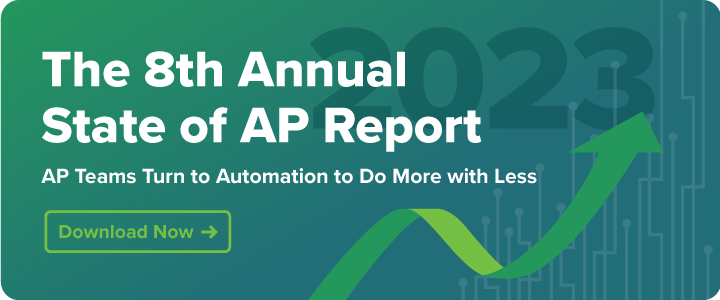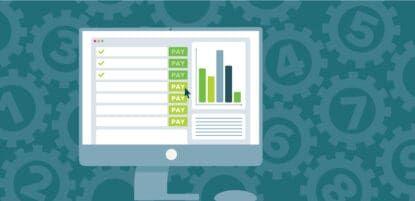As all accounts payable managers know, AP processing is among the most manual, time-consuming, and cumbersome processes in accounting. With at least 50% of all B2B payments being made manually with paper checks today, one thing is abundantly clear: There is a world of opportunity to save time at every step of accounts payable process.
Understanding the Accounts Payable Process
The accounts payable process is responsible for the handling and payment of vendor invoices and expenses. This includes invoice capture, invoice approval, payment authorization, payment execution, analytics and optimization. Effectively understanding the accounts payable process is crucial for maintaining accurate financial records, managing cash flow, and building strong vendor relationships. But understanding the AP process is just the first part of creating a streamlined process. The next is to effectively organize your accounts payable process.
7 Tips to Organize Your Accounts Payable Process
From the time that a vendor sends you an invoice, to the time you send your payment, there are numerous ways to save valuable time and to manage your AP department more effectively. Here are some simple tips to save time throughout your accounts payable process:
Tip 1: Centralize Invoice Processing
If you’re trying to save time, there’s nothing worse than paying the same invoice twice. Not only was time wasted while processing the redundant payment, but now you must also dedicate even more time to re-balance your books and reconcile with your vendor to set up a credit.
Especially for companies that have invoice processing happening in multiple locations, it’s easy to fall victim to this type of mistake. For this reason, dedicating one central location to process and pay every invoice can drastically reduce the number of times these costly mistakes happen, and save you a lot of time.
Tip 2: Establish a Routine Employee Training Process
There are a lot of variables that go into every vendor payment. Some of this variety is unavoidable, but some of it is not. While the departments responsible for the invoice and the way that the vendor delivers it can be constantly changing, the way in which your team manages the process of capturing, approving, and making the payment is something that you can keep constant.
Planning ahead for how to handle each of the different types of invoices you receive can help save a lot of time. Establish consistent processes, train all employees to follow it, and then stick to that process every time an invoice is received. This will simplify your accounts payable, and enable both you and your entire company to become even more efficient through repetition of a familiar process, as well as help to avoid errors from less experienced hires that are unfamiliar with best practices within the AP process.
Tip 3: Capture Invoices in Small Doses
The more time you spend performing manual data entry, the more prone to mistakes you become over time. As vendor invoices trickle in, it is tempting to put off the process of capturing them to a future point in time that you can knock them all out in fell swoop. However, this practice will increase both the number of mistakes and resources required for reconciling them.
Capturing your invoices in smaller doses will help to limit errors and the amount of time you spend correcting mistakes.
Tip 4: Establish Clear Approval Workflows
Defining a clear approval workflow for invoice processing and payment authorization helps to organize the entire accounts payable process. The reason being, when there is a clear breakdown of who should be reviewing and approving payments, businesses can ensure proper review and approval from relevant stakeholders, all while avoiding unnecessary delays.
Tip 5: Conduct Regular Audits
AP audits are an effective way to identify errors within your process, ensure compliance, identify areas where your process could be improved, assess internal controls, and much more. Conducting regular audits can help build an audit trail within your AP department which helps to streamline and organize the entire AP process.
Tip 6: Communicate Effectively with Vendors
Building and maintaining strong vendor relationships is an essential part of creating a sturdy accounts payable department. Maintaining open communication with vendors and paying invoices on time will help your AP process to address concerns, clarify expectations, resolve discrepancies, as well as take advantage of early pay discounts. Vendor self-service portals are a great way to establish open communication, as they are an integrated online platform that allows vendors to view, add, and maintain information simplifying the entire buyer/supplier relationship.
Communicating effectively with your vendors contributes to organizing the AP process by minimizing errors, streamlining communication channels, and fostering positive vendor relationships, ultimately leading to a more efficient and effective AP process.
Tip 7: Automate the Entire Invoice-to-Pay Process
Investing in an accounts payable automation solution has saved companies as much as 64 hours each month. However, a key to maximizing your investment in automation is choosing a solution that automates the entire invoice-to-pay process, and not just an individual component within that process.
How to Establish an Organized and Efficient AP Process with MineralTree
MineralTree TotalAP builds all of the best practices discussed above into your accounts payable process by integrating with your corporate bank account and common accounting systems, such as Oracle (NetSuite, EBS, ERP Cloud, JDE, PeopleSoft); SAP; QuickBooks (Desktop, Online); Microsoft Dynamics (Business Central, Great Plains, Finance & Operations); and Sage (Intacct, 50, 100).
Curious to see what your accounts payable process would look like with automation? Contact MineralTree for a complimentary assessment of your projected savings with AP Automation.
Frequently Asked Questions
How do you organize accounts payable?
Organizing accounts payable can be accomplished by centralizing invoice processing, conducting regular audits, establishing routine employee training, communicating with vendors, creating clear approval workflows, and automating the invoice-to-pay process.
What is a good strategy in managing accounts payable?
A good strategy to manage accounts payable includes implementing efficient AP processes, conducting regular audits, establishing strong vendor relationships, and ensuring timely and accurate vendor payments.
What are the 4 functions of accounts payable?
The 4 primary functions of accounts payable include invoice capture, invoice processing, invoice approval, and invoice payment.
What makes a good accounts payable team?
A good accounts payable team includes employees that are organized, have strong communication skills, pay attention to detail, and have a deep understanding of accounting principles, financial processes, and relevant regulations.




